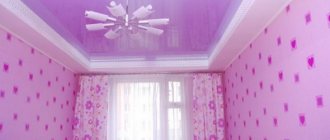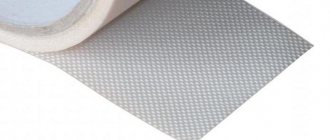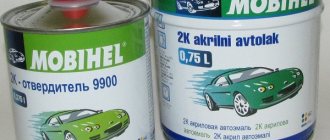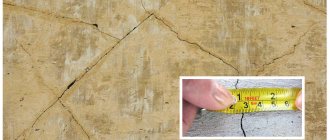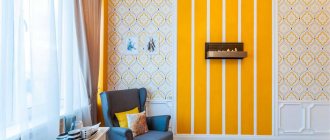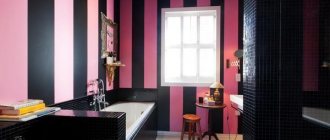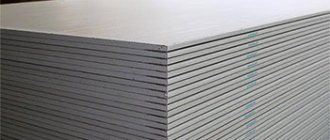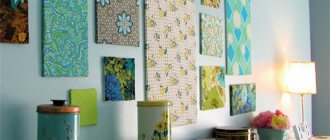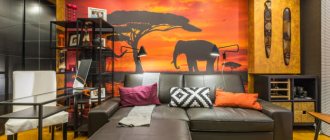Recently, the widespread monotony of home interiors, achieved by ideally painting the walls in the desired shade, is gradually going out of fashion. Designers favor bright colors, patterns and designs, especially geometric ones. The cage, the existence of which ordinary people have not forgotten, is again at the peak of popularity, because it is the cage that can make the atmosphere homely or slightly austere, brutal or rustic. The cage is always appropriate in the interior of the kitchen; it is combined with many style trends, giving the room brightness, zest, and personal flavor.
Types of checkered patterns and their features
The check is such an old pattern that for many countries it has become a kind of national treasure (starting with the Scottish clans with their “signature” kilt colors). At the same time, choosing the wallpaper, sofa, flooring or textiles that is suitable for your kitchen will be much easier if you know the characteristic features of the main types of checkered patterns and their compatibility with different interior styles.
The list of basic check patterns includes:
- tartan or tartan;
- checkerboard pattern (argyle, glencheck);
- Vichy;
- gyneme;
- patchwork (not quite a checkered pattern, but a pattern of square elements).
What styles can plaid be used in?
A checkerboard is not just clear lines, it can be used to create interiors of different styles: for example, clear and strict lines, objects with right angles are suitable for a chess interior; there is no place for various figurines and cheerful flower pots. But this style will go very well with modern furniture and appliances. You can make a checkered background: mainly for this purpose, choose products with a dim but large checkered print: bedspreads, pillows, checkered curtains, carpets - all this can be used to create such an interior. The check is also suitable for the classic style: it is characterized by a mosaic effect, as well as a combination of checkered patterns made of rich fabrics, natural stone or wood. White-blue and red-white checkered patterns are a great option for a rural house. You can highlight the ethnic style with a checkered pattern, but the interior must contain national motifs, and the colors must be unusual (cream, turquoise, lilac and others).
In the interior, checkered motifs are good because they are unobtrusive and orderly, so a person easily gets used to them and does not feel discomfort. Ornament can affect the interior in completely opposite directions: make it light or dark, respectable or cheerful, colorful or solid.
Good old England. The first thing that comes to mind when we think of a tartan check is a cozy blanket decorated with such an ornament, a rocking chair, a burning fireplace, light twilight - all components of the traditional English style in the interior.
The Scottish pattern is called tartan: it consists of lines intertwined perpendicularly, resulting in the formation of rectangles. There are many variations of tartan, you can combine the most bizarre colors, and to this day the Scottish check is the favorite pattern of the British, so it is one of the main style-forming elements of the interior in the English or Scottish style. Most often, a checkered pattern is applied to the upholstery of upholstered furniture, but checkered wallpaper, tablecloths or curtains are also often used. In the hall or corridor, you can use flooring or rugs with geometric patterns.
For the English style, a blue-and-white, black-and-white or black-and-red interpretation is preferred. When choosing accessories, take a closer look at chairs with checkered upholstery, fabric lampshades, and pillows with a characteristic pattern.
Country style. The cage fits very harmoniously into the style of a “country house”. This pattern is especially often used in the kitchen or living room; the checkered print is presented on curtains, tablecloths, napkins, furniture covers, pillows and even on carpets. You can put checkered furniture in the living room, but then the wallpaper and flooring should be plain; in the bedroom, you can decorate the headboard with checkered fabric. By the way, for country style they often use a cage that looks like it has been bleached by the sun; it will be less contrasting, but amazingly matches the theme. You can combine geometry with floral prints, homespun lace, and ruffles.
Modern interior . In modern-style interiors, the cage is accentuated: its task is to dilute the monochrome interior. For example, you can decorate one wall with a checkered print or purchase furniture with bright checkered upholstery and install several lampshades. If you add a little checkered pattern to the design of the room, then the room will be perceived differently. “Check” has always been considered a masculine pattern, so it can be used to dilute pastel colors and make common areas more harmonious.
A game of contrasts. This technique is very relevant, because it makes the interior more rich and original. Black and white interiors are in fashion, but you can combine bright checkered patterns with pastel colors. Try to use no more than two different patterns in the interior, otherwise the room will seem disjointed and alien. An interesting combination is tartan with a regular check. Stripes and checks will look interesting: for example, in the center of the room you can put a checkered sofa and two striped armchairs. The cage can be a wonderful backdrop for rounded and streamlined furniture; it can be complemented with floral or ethnic patterns. An interesting duet is presented by a leather set and checkered textiles (curtains, carpet, pillows, etc.). But it is better to avoid an abundance of decorative elements in a checkered interior, otherwise instead of orderliness you will get chaos, so it is better to hang one favorite painting on the wall than a dozen photographs or posters. The cage is not intended for luxurious interior styles such as art deco, rococo or baroque.
Plaid or tartan in the interior
The word tartan translates as “the color of the area,” and it was tartans that served as the basis for the famous Scottish kilts, whose patterns vary from clan to clan. In addition to clan plaid skirts, a special tartan was created for the Burberry brand, which became its trademark - red, black and white stripes of different thicknesses, forming checkers on a beige background. The “houndstooth” and “pepita” patterns are variations of the classic tartan and are distinguished by the asymmetrical shape of the elements; they are more often used in textiles.
Classic tartan is characterized by a bright background - red, blue, green, sometimes yellow and ocher, as in the photo below. This type of pattern goes well with a brutal kitchen interior in a chalet, country style, strict geometric furniture shapes, square moldings, as well as retro or vintage styles. If textiles, curtains, a sofa or part of a wall are upholstered in tartan, the remaining surfaces should match the color of the stripes on the tartan and be monochromatic. A bold decision - a combination of checks and patterns - can only be entrusted to an experienced designer with delicate taste.
One of the varieties of tartan is country plaid, using soft and non-contrasting threads. Scottish and country patterns in the kitchen go well with items made of natural materials: wood, stone, metal (for example, kitchen utensils), with furniture made of leather, wood, brick walls, and loft elements.
Features of use
As we have already said, it is best to let a professional designer work with the cage, but if we don’t have one at our disposal, then we can try to build the interior ourselves, based on the basic rules for using wallpaper with a Scottish theme.
There are plenty of subtleties and nuances when working with checkered English wallpaper. It is advisable to use natural materials for finishing: wood, iron, stone. It is important to choose the right decorative elements, high-quality textiles for curtains, and noble wood furniture. Ideally, when decorating a room in tartan colors, you need to have at least a vague idea of Scotland and its tartan. By the way, tartan literally means “Scottish check”.
In ancient times, the design and color of the tartan indicated that a resident of Scotland belonged to a particular clan. Every resident of this country was proud of his pattern and its colors, because it clearly showed how rich his region was, what natural resources it had. In those days, colors were only natural, and everyone knew what they were made from.
Related article: Mixture for floor screed: which is better and proportions for pouring
Contrasting interior of a small bedroom
Traditional Scottish kilts, made in the colors of a particular region of the country, are still worn, but this is rather a tribute to tradition. Much has changed since those long ago days, and Scotland is no longer the same independent mountainous country. However, the classic pattern has taken its rightful place in the world of art; now this print is used on clothing, interior items and, of course, wallpaper.
An interesting detail: many people liked tartan, otherwise how can one explain its appearance in such an American style as country. This style is also not new; its roots go back to ancient times, when proven techniques were used to decorate homes.
Note that the cage used in country style can be made of both dark and light colors.
Unlike prim English interiors, in country style the atmosphere is very relaxed, as softer and lighter colors are used here. At the same time, a huge number of vintage accessories indicate the long traditions of this style.
By the way, checkered wallpaper options can be interspersed into any interior in the form of inserts framed by frames and baguettes. An original solution would also be to insert pieces of wallpaper into a picture frame and hang it on the wall.
Wallpaper for walls in an original checkered pattern can be rich and bright, or it can be faded, with a barely noticeable pattern. From a distance they will look like one color, but when you get closer, the pattern will appear. This effect is achieved by using different tones of the same color, for example, a combination of brown, beige and brown will look very original.
Modern German wallpaper from a famous brand
When choosing wallpaper with a checkered pattern, focus on the basic color scheme of your interior. Most often in wallpaper stores you can find patterns of classic black and white colors, blue, green, red, brown tones. In this case, combinations of several colors are most often found.
Note that such an original design is not only aesthetically attractive, but also practically has a number of advantages, for example, it emphasizes the geometry of the room and hides minor defects in the walls.
Rich in colors and interesting design immediately attracts attention and makes you not pay attention to minor points. Therefore, if you do not have the highest quality preparation of walls for wallpaper, then you may well consider this design option.
Thus, you can use a checkered pattern for wallpaper in any room, the main thing is to correctly build the entire interior, choose sociable wallpaper, furniture, and accessories.
Chess square
A chess cell is a uniform combination of squares of two colors in a checkerboard pattern. A variety of chessboards are argyle (a classic chessboard) and glencheck (a small black and white checkerboard, which soon begins to dazzle the eyes). Black and white check is one of the most current trends since time immemorial. This cage is often used in kitchen interiors in loft, high-tech, modern, and minimalist styles for finishing the floor or part of the walls. If a black and white checkered pattern seems too bright and intrusive to you, use it sparingly: in tablecloths, sofa upholstery, and chair cushions. You can choose a softer three-color option interspersed with beige or brown. For retro and vintage styles, it is important to cover the floor with tiles or linoleum in a red-white or blue-white checker.
Cage in the bathroom
In the bathroom, checkered patterns look the most organic, because essentially tiles (the most popular finishing material) already have a square or rectangular shape, and if you play with contrasts, the option will really be a win-win! You can combine not only black and white, but also white and green, blue, beige and brown and other colors. The plumbing fixtures are also matched, and finding a couple of little things in a check pattern (towels or rugs) is not such a problem.
By the way, the good thing about a cage is that it hides the imperfections of the room, so if your bathroom can’t boast of perfect walls, you can disguise the errors with a bright cage.
French Vichy checkered design in the kitchen interior
Vichy check originates from France. Initially, this pattern was used only in fabrics and was produced in three variations, representing an interweaving of white and blue, white and red, or white and black stripes. An intermediate tone is obtained when these stripes intersect. The first two options, both in curtains and upholstery of sofas, tablecloths, and in wall decoration, will harmoniously fit into the interior of a retro or vintage kitchen. Yellow-white, cream-white, blue and white checkered patterns will take root in a kitchen in Provence or country style, as in the photo example.
Rustic and provincial interiors allow you to combine delicate Vichy patterns with pastel solid surfaces and other patterns with a similar combination of shades, such as floral upholstery or wallpaper. Vichy check goes well with wooden furniture and utensils, matting rugs, rough surfaces, and shabby items in the shabby chic style.
An example of a checkered interior
Well, let's start looking at the finished and already implemented design. Today we will go to Moscow, to a new building that appeared before my eyes without walls, with a pair of load-bearing pillars and a 3 m ceiling.
General view of the dining area
Such a clean space is a designer’s dream, allowing any owner’s wishes to come true. As a result, I got a full-fledged apartment for a family with three bedrooms, a living room-studio and two bathrooms.
| Location | Moscow |
| Square | 156 m² |
| For whom | married couple with a 10 year old child |
| Style | classical |
Dining room-living room
General view of the living room
The dining room is separated from the living room by a high portal. This made it possible to zone the space, but not to build monolithic walls.
Due to its height, the ceiling turned into a complex multi-level structure. The lowest point was at the ventilation, the next part with built-in music speakers and lamps was a little higher. In the center of the room we managed to maintain the “native” height.
Checkered interior in detail
The same fabrics are used for furniture upholstery (sofas, chairs, armchairs) and window textiles. One of the sofas is classic English, the second is equipped with a sliding mechanism.
The floor is laid with herringbone parquet made of natural solid oak.
Some of the kitchen cabinets were installed in the dining room; this solution helped make the space a logical continuation of the kitchen area. An additional refrigerator is hidden in a high cabinet, and on a small countertop there is space for a coffee machine and kettle. Thanks to this mini-kitchen, the owners have everything at hand during meals.
Decorating upholstered furniture with checkered fabric
To provide stylistic support for the dining area, similar cabinets were installed in the living room, visually lightened with light wooden frames. The latter are identical to the decorative portals leading to the dining room, corridor and kitchen.
Armchairs, furniture decor and checkered curtains in the living room interior
Wooden panels of the same shade as the cabinets are mounted behind the TV; they create the integrity and compositional completeness of the interior.
The interior is dominated by classics; there are practically no modern design elements left in it. An exception is the LED strip built around the perimeter of the ceiling.
For the living room used:
- lamp table and coffee table – Angelo Cappellini;
- chandelier, sconce – Artemis;
- table lamp – Estro;
- armchair – Marie's Corner;
- wallpaper – Flamant;
- backlight – Luce;
- ceiling cornices – “Europlast”;
- cabinets – Scavolini;
- sofa upholstery – Wade Upholstery.
Corridor
Multi-level ceiling and corridor lighting
The walls in the corridor are decorated with cream-colored wallpaper with an imitation matting texture, and there are tiles on the floor. There are tall wardrobes on the left side. On the right is a dressing room equipped with open cabinets.
A little cage on the floor in the hallway
An LED strip is installed on the ceiling in the hallway, allowing you to create different lighting scenarios.
Bathroom and toilet
Guest bathroom design
The guest bathroom was decorated in contrasting, darker and richer colors. The upper part of the wall surface is covered with vinyl wallpaper, the coating of which imitates natural leather. At the bottom there are ceramic tiles with imitation wall panels.
For the guest bathroom used:
- wallpaper – Thibaut;
- chandelier – Luce;
- sink – Villeroy&Boch;
- tile – laDiva Ceramiche.
Bedroom bathroom design
The walls of the bedroom bathroom are decorated with combined materials: the bath area is tiles, the rest of the room is wallpaper in the same color as those used in the bedroom.
When gluing wallpaper in bathrooms, it is important to use special compounds that increase the strength of the coating and increase its water-repellent properties.
For the bathroom used:
- faucets and accessories – Nicolazzi;
- chandeliers and sconces – Savoy;
- bath – Villeroy&Boch;
- tile – Ceramiche Grazia;
- wallpaper – Seabrook;
- toilet and sink – Globo.
Children's room
In the photo - a children's room with a checkered headboard
The children's room was decorated at the request of its owner. A ten-year-old boy firmly stated that he wanted a blue and white checkered pattern. This cage appeared at the head of the bed.
A mirror was fixed to the inside of the door leaf; in it you can see a cabinet with a “bridge”.
The highlight was the bed, which turned from an ordinary standard model into a unique design object. I painted it a light color and added fabric.
Used in the nursery:
- chandelier, table lamp, armchairs – Eichholtz;
- headboard – JLC;
- backlight – Artemis;
- wallpaper – Thibaut;
- wallpaper – Seabrook Design.
Bedrooms
Women's bedroom
The master bedroom received a calm and peaceful interior. The walls are covered with wallpaper imitating silk. The bed upholstery and window textiles are made in the same lilac shades.
Men's bedroom-office
The apartment also has a bedroom-office. Here, next to the bed, there are bookshelves and a large work area. The interior is designed in calm and “serious” colors.
Lightweight gynema cage
The gingham checkered pattern is used for thin, lightweight fabrics and is suitable for sewing curtains, napkins and other kitchen textiles in Provence, retro, country, and colonial styles. The pattern itself comes from India, which explains its airiness; this decor is ideal for creating a feeling of spaciousness. Ginem has three shades, does not go well with leather and plant prints, but is ideal with light plain surfaces. This check is considered one of the varieties of the Vichy pattern and is distinguished by greater brightness and large checks.
Patchwork style cage in the kitchen
Patchwork can be called a checkered pattern only with some stretch, but thanks to the square variegated elements, it is very close to the check. Initially, patchwork was used by housewives to transform old things into new ones. New ones were sewn from pieces of old clothes, and if this was unrealistic, then rugs, blankets, rugs and other home textiles. Today, many needlewomen continue this good tradition, but not out of necessity, but out of love for art: the patchwork technique is quite simple and allows you to create stunningly bright, stylish, colorful things.
Manufacturers of wallpaper, floor tiles and tiles are not lagging behind handicraftsmen: patchwork-style coverings decorate the most fashionable kitchens. This trend fits perfectly into the concept of interiors in the spirit of country, Russian rustic, Mediterranean, and Moroccan styles. In floor tiles and kitchen backsplashes, patchwork goes well with a checkerboard pattern, as in the photo below.
Where to use a cage in kitchen interiors?
Checkered patterns in the interior of kitchens can appear in the decor (partial decoration of walls, columns, partitions, aprons, countertops), floor and even ceiling coverings, as well as in textiles (upholstery of sofas, curtains, napkins, tablecloths, covers on chairs and pillows). A checkered pattern is a fairly aggressive pattern, even if it is made in neutral colors, so it must be applied in doses. For example, for a bright and large plaid, you can select only part of the wall; Vichy check and guineme can cover the walls completely. If the cage is used in textiles, two or three items are enough, they will become bright accents in your kitchen (for example, curtains and sofa cushions or tablecloth in a similar color), as in the photo.
